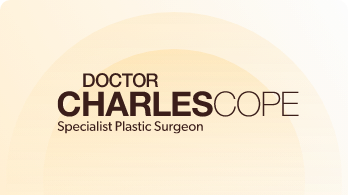Breast implants do not last forever, and the exchange of breast implants can become necessary for many reasons – some of these are due to original implant choice and position, while some are due to way the body has healed after the surgery or changes in the breast itself with time or pregnancy/breast feeding.
Dr Cope sees many patients from other surgeons both in Australia and overseas who need implants exchanged or breast augmentation revision surgery.

This surgery is much more complicated than the first breast augmentation surgery and has more risks associated with the surgery.
Some of the most common reasons for having implant revision include:
- displacement of the implant position, which causes either a too wide or too narrow cleavage, or a ‘double-bubble’ if the implant is lower than the breast
- capsular contracture, when your body’s scar around the implant becomes firm
- rippling, when the amount of tissue covering your implant is too thin
- change in implant size (either up or down) or change in shape
- the breast has become droopier over time, especially with pregnancy and breast feeding
For more information on breast implant options see the breast augmentation page.
Frequently Asked Questions
The result of breast augmentation with breast implants often changes with time, either due to changes in the implant capsule (scar tissue around the implant) which can cause the implant to change position or become hard & uncomfortable, or changes in your own breasts, which commonly often occur after pregnancy, breast feeding and weight loss. If these changes are causing symptoms or bothering you, they can often be improved with a breast augmentation revision.
Breast augmentation revision can be performed at any age , but if you are about to have children soon then you should wait until after pregnancy and breast feeding, as these often change your breasts and change the result of breast augmentation revision – if you are young and this is many years away then this may not be an issue. Many patients also have breast augmentation after having children to correct changes that have occurred with pregnancy and breast feeding.
A breast augmentation is not permanent, but usually lasts 10-15 years*. How long it lasts depends on the size of your breasts (larger breasts drop faster if they are not well supported), weight fluctuations and hormonal changes. Even if your weight is stable then hormonal changes such as pregnancy, breast feeding & menopause can cause your breasts to change, possibly requiring another operation. Also, as time goes on the chance of having something happen to the breast implants also increases.
Usually the incision that was used previously is used again, although sometimes a new incision placed in the crease underneath the breast is needed – this allows the surgeon to give the best placement of the implant, modification of breast tissue if needed and the best cosmetic result of breast augmentation revision.
If you have been happy with the long-term result of your breast implants then usually the same pocket is used again. However sometimes a change of pocket is required to give the best chance of fixing problems, Breast implants placed underneath the pectoralis major muscle gives a more natural shape, a lower chance of long-term problems such as capsular contracture and rippling, and it is easier for mammography, but if you have been happy with your implants over the muscle the same pocket will be used again.
Breast implants are available as round or shaped implants – which one is right for you depends on many factors such as the result you are trying to achieve, how thin you are, how much breast tissue you have naturally, what shape your breast is and what size implant you want. If you are thin and want a natural result, so that no one knows you have breast implants, a shaped implant may be the best choice. If you have a reasonable amount of breast tissue before the surgery or want more upper pole fullness, then a round implant may be a better choice. Dr Charles Cope will discuss these options with you.
Modern cohesive silicone implants have had a textured surface for 30 years, with far fewer problems than the old type of smooth implants that were used in the 70s and 80s. The commonest cohesive silicone implants used in Australia are produced by Mentor (owned by Johnson & Johnson), and have a long track record. There are newer modern versions of the smooth silicone implants (e.g. those made by Motiva), which some patients are choosing because of the rare risk of BIA-ALCL (breast implant associated anaplastic large cell lymphoma), which is associated with textured breast implants. Dr Charles Cope will discuss these options with you.
Modern breast implants have been around for 30 years with few problems; however, they do not last forever. As time goes on the chance of having some problem with your breast implants increases – possible problems include capsular contracture, implant displacement or movement and rupture. On average implants last 10-15 years*, with 2-3% of people needing another operation every year. If you are lucky implants can last 30-40 years without problems*.
There have been increasing reports of a rare form of cancer associated with textured breast implants – BIA-ALCL (breast implant associated anaplastic large cell lymphoma). This is rare (estimates run at about 1:36,000) – you are much more likely to be killed in a car accident (1:6000 per year in NSW)
As time goes on the chance of having some problem with your breast implants increases – possible problems include capsular contracture, implant displacement or movement and rupture. On average implants last 10-15 years*, with 2-3% of people needing another operation every year. If you are lucky implants can last 30-40 years without problems*.
The operation is performed as a day-surgery or overnight stay procedure in an accredited hospital, depending on what you are like with anaesthetic recovery.
It is normal for scars to be red, lumpy and obvious for 6-8 weeks after surgery. After this they gradually fade, with most people’s scars being white by one year, although uncommonly this process can take 2 or more years*. The simplest way to help this process is to keep tape such as Micropore tape or silicone tape on the scars for the first 3 months or so. An alternative to this is to massage the scars. It is rare to have obvious scars after breast augmentation – most people can sunbathe topless without problems once the scars have faded*.
During the first week after surgery you need to rest and take things quietly at home. When you go home there will be waterproof dressings covering your breasts, which normally stay on for one week, allowing you to shower normally. Most people find these dressings supportive, but if you find it more comfortable to wear a supportive sports bra that’s fine. Some people feel well enough to drive to the postoperative visit, which is usually 5-7 days later*. Most people return to office work within 10 days after breast augmentation revision*.
For most people it is 4 weeks until they are ready to return to sport and full activities*.
*Note results vary from patient to patient



